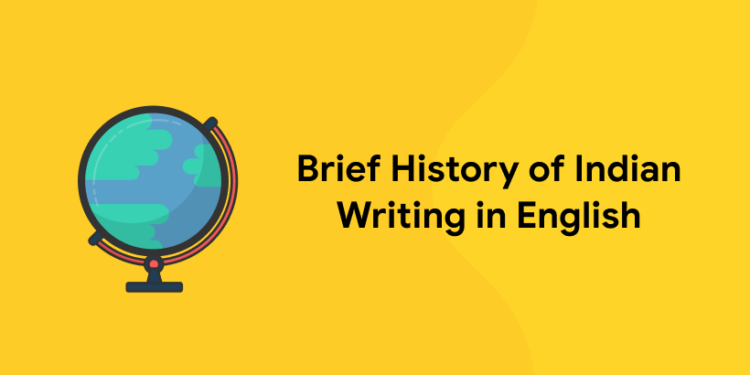Table of Contents
Indian English Literature is a realistic scenario that endeavour to manifest the evergreen gems of Indian Writing in English. From being a singular and exceptional, wide spread of native geniuses, Indian Writing has emerged as a new formation of Indian culture and voice in which India counters regularly. Indian Writers – poets, novelists, essayists, and dramatists turned out to make momentous and considerable contributions to world literature since before the independence of our nation. The past few years have been observed an immense flourishing and progress of Indian English Writing through worldwide.
Indian English Literature has attained an independent status in the area of world Literature. Wide ranges of themes are distribute within Indian Writing in English. While this literature continues to contemplate Indian culture, tradition, social and moral values and even Indian history that portrays the lifestyle and culture of Indians. Present Indian English fiction has been trying to give expression to the Indian experience of the modern circumstances.

Brief History of Indian Writing in English – Quiz PDF Download
History of Indian Writing in English
Indian Writing in English is basically started during the British rule in India .Indian writing in English began with the emergence of East India Company in India. As East India Company spread its wing through southern peninsula, English language started to get newer pockets of influence. But it was still time for the first English book to capitalize. Late 17th century saw the coming of printing press in India but the publication were largely confined to either printing Bible or government decrees. Then came newspapers. It was in 1779 that the first English Newspaper named Hickey’s Bengal Gazette was published in India. The breakthrough in Indian English literature came in 1793 A.D. when a person by the name of Sake Dean Mahomet published a book in London titled Travels of Dean Mahomet. This was essentially Mahomet’s travel narrative that can be put somewhere between a Non-Fiction and a Travelogue. It is relatively not so old, as it is one and half centuries old.
Early Indian writers used English unmixed by Indian words to demise an expression which was basically Indian. Apart from the freedom struggle that awakened many of the Indians who fought for the freedom, the writers at that time were able to transmit their point of view, which ultimately helped to motivate and guide the crowds. The happiness of accomplishing the magnificent victory against the British rulers was suddenly spoiled by the shocking and traumatic partition of 1947. The horrors, tragic consequences and partition like the large scale migration, adventurous looting and merciless massacres were portrayed by the writers in their works which captured the interest, and imagination of the reader, the Indian English novels began to prove its mark towards the global dignified storyline. English novels began to prove its mark towards the global dignified storyline.
The first connection that we should be looking at is the introduction of the English language as a medium of instruction in India and the introduction of English literature as a subject in the Universities. Earlier Indians have to meet two preconditions before writing a poetry in English. First, the English language had to be sufficiently Indianized to be able to express the reality of the Indian condition. Secondly, Indians had to be sufficiently Anglicized to use the English language to express themselves. English was, as a result, introduced in educational institutions, Courts and offices thus displacing the traditional use of Arabic and Sanskrit as a mode of communication and documentation. In 1835 Lord William Bentinck announced that the government would “favour English Language alone” therefore would move towards “a knowledge of English literature and Science through the medium of English language alone.”
The period between 1850 and 1900 is the mimetic phase when the Indian poets were romantic poets in the Indian garb or in George Bottomley’s words “Matthew Arnold in a saree” or as some slanderingly observes “Shakuntala in a mini-skirt”. The period from 1900 to 1947 is the absorbtive period when the Indian poets still romantic tried to absorb the romanticism of the early nineteenth century. British poets and the “new” romantics of the decadent period for expressing the consciousness of the Indian renaissance between nationalism and political changes which ultimately led to the achievement of political freedom in 1947.
The second generation poets were, still romantic in spirit were Sarojini Naidu, Tagore, Aurobindo Ghose and Harindranth Chattopadhyaya. The poetic output of these poets was fecund in nature. Romanticism of these Indian poets was distressed with nationalism, spirituality and mysticism. It was therefore different from English romanticism, Indian romanticism widened the poet’s vision. While Aurbindo’s was the search for the Divine in Man and Tagore’s was the hunt for the Beautiful in Man and Nature. Both were philosophic poets. Sarojini Naidu’s romantic impulse highlighted the beauty and richness of traditional Indian life and culture.
The beginning of the 20th century saw a gradual growth of the novel form in English in India. Romesh Chandra Dutt was an important figure writing at that time. However one name that stands apart from this body is that of Rabindranath Tagore. It would be inapt to appropriate him as a writer of English because he wrote with equal felicity and grace in Bengali. As a matter of fact he was not known as a writer alone but as an equally accomplished poet, playwright and painter.
It was in late seventies that a new breed of Convent, boarding school educated and elite class of novelists and writers started to work on English literature. The likes of Salman Rushdie, Vikram Seth, Amitabh Ghosh and Dominique Lepierre set the literature world on fire. Rushdie’s Midnight Children won Booker in 1981 and send the message loud and clear that Indians are here to stay. Arundhati Roy and Kiran Desai repeated the feat when they won Man Booker in the year 1997 and 2006 respectively. In the mean time, a new crop of authors such as Pankaj Misra, Chetan Bhagat, Jhumpa Lahiri, William Dalrymple, Hari Kunzuru have arrived on the international scene and their writings are being appreciated round the globe. A special mention to Jhumpa Lahiri and her work; the inspiration of her work stems from the emotional crisis generated from cultural Diaspora and identity crisis that Indians suffer from when they live outside the boundaries of their own culture and geographical setting.
Attempt Free GK Mock Test ! Download ENTRI App !
Importance of English Literature in India
1: Who was the first woman President of India?
English as a global language has highly influenced the literature of India. The history of Indian Writing in English began with the The Indian Writing in English can be compared to an old stinging root which has regrowned its branches in the modern generation. The new saplings are thriving with green leaves and twigs to be enjoyed by all not only in the Indian landmass , but across the globe as well.
Many English newspapers like The Bengal Gazette, The Bombay Herald, The Madras Courier came to gratify the needs of the infuriated youth during the freedom struggle. These English newspapers linked the entire nation with a common feeling of national spirit and by English education in India was initiated with the sole purpose of modifying British interests to inspire Indians with the western thoughts which sooner or later were meant to fortify foreign supremacy. Lord Maculay, British historian and politician strongly believed in anglicizing the education system in India. Macaulay’s Minute on Indian Education published in 1835 is considered as an important account in this regard. His ideas were based on an assumption of the intrinsic authority of British ethnicity, a vital remark which is documented in Macaulay’s Minute: bonded them together with a common agenda of nation’s freedom.
Free UPSKILLING Courses!
Take your first step toward mastering in-demand skills, acing interviews, and securing top-tier jobs with Entri's free upskilling courses.
Start Learning!Role of Woman Authors in English Literature
Women novelists have played a crucial and momentous role in enhancing the quality and quantity of the Indian English Fiction. They have further added the woman’s perspective and feministic dimensions to the novels. These rich contributions have widened the spectrum of issues intended in the novel. Earlier because of some patriarchal assumptions Indian women authors has always been underrated. Indian societies gave more priorities to male authors. In those days, women used to write about a women’s perception and experiences within the domestic sphere. As male authors are used to deal with heavy subjects, that their work would get more priority and acceptance in the society. These assumptions led to the declaration of women writing in eighteenth century. In the nineteenth century, more and more women actively participated in India’s revolutionary movement against the British rule. It again led to the women’s literature. At that time, their write – ups mainly concentrated on the country’s freedom struggle. Over the years, the world of feminist ideologies began to influence the English literature of India.
The contributions by women writers cannot go unnoticed. In fact the works by women writers constitute a major segment of the contemporary Indian writing in English. Today women are seen establishing their identity in almost all walks of life and they have heralded a new consciousness in the realm of literature too.
Grab The Latest GK Study Materials – Download ENTRI App !
Indian writing in English has commended magnanimous respect in both home and abroad, is now in its full wave. It has shaped out a new track, a new vision – a vision that is replete with an unanswering faith and hope, myths and traditions, customs and rights etc. If we dive deep into the works of the Indian stouts of English fictions, it is revealed that their works are not an imitation of English literary pattern but highly original and intensely Indian in both theme and spirit. They have given a new shape and color to English literature in the same way as the Australians and Americans have evolved their own literature in their respective countries.
Must Read Gems of Indian English Literature
- The Story Of My Experiments With The Truth – Mahatma Gandhi
- Gitanjali – Ranindranath Tagore
- The Guide – R.K Narayan
- A Fine Balance – Rohinton Mistry
- Midnight’s Children – Salman Rushdie
- A Suitable Boy – Vikram Seth
- God of Small Things – Arundathi Roy
- The Glass Palace – Amitav Ghosh
- The Inheritance of Loss – Kiran Desai
- The Private Life of an Indian Prince – Mulk Raj Anand
- Rich Like Us – Nayantara Sahgal
- The Autobiography of an Unknown Indian – Nirad C . Choudhuri
Brief History of Indian Writing in English – Quiz!
- Q: Who is considered the father of Indian English literature?
A: Raja Rammohan Roy is often referred to as the father of Indian English literature.
- Q: Which was the first novel written by an Indian in English?
A: The first novel written by an Indian in English is “Rajmohan’s Wife” by Bankim Chandra Chattopadhyay.
- Q: Who wrote the famous Indian English novel “Untouchable”?
A: “Untouchable” was written by Mulk Raj Anand.
- Q: Which Indian author won the Nobel Prize in Literature in 1913?
A: Rabindranath Tagore became the first Indian and non-European to win the Nobel Prize in Literature.
- Q: Who wrote the renowned historical novel “The Great Indian Novel”?
A: “The Great Indian Novel” was written by Shashi Tharoor.
- Q: Who authored the book “Midnight’s Children,” which won the Booker Prize in 1981?
A: “Midnight’s Children” was written by Salman Rushdie.
- Q: Who is considered the pioneer of Indian English poetry?
A: Henry Louis Vivian Derozio is regarded as the pioneer of Indian English poetry.
- Q: Which famous Indian poet wrote the collection “Gitanjali”?
A: “Gitanjali” was written by Rabindranath Tagore.
- Q: Who wrote the novel “A Suitable Boy” set in post-independence India?
A: Vikram Seth is the author of “A Suitable Boy.”
- Q: Which Indian English poet penned the poem “An Atlas of the Difficult World”?
A: Adrienne Rich, an American poet, wrote “An Atlas of the Difficult World,” not an Indian poet.
- Q: Who wrote the book “Train to Pakistan”?
A: “Train to Pakistan” was written by Khushwant Singh.
- Q: Which Indian author’s works include “The Shadow Lines” and “The Glass Palace”?
A: Amitav Ghosh is the author of “The Shadow Lines” and “The Glass Palace.”
- Q: Who wrote the novel “English, August”?
A: “English, August” was written by Upamanyu Chatterjee.
- Q: Which Indian author wrote the novel “The God of Small Things”?
A: “The God of Small Things” was written by Arundhati Roy.
- Q: Who is the author of the book “A Passage to England”?
A: Nirad C. Chaudhuri is the author of “A Passage to England.”
- Q: Who wrote the novel “Fasting, Feasting”?
A: “Fasting, Feasting” was written by Anita Desai.
- Q: Who authored the novel “The Inheritance of Loss”?
A: “The Inheritance of Loss” was written by Kiran Desai.
- Q: Which Indian writer’s work includes the novel “The White Tiger”?
A: “The White Tiger” was written by Aravind Adiga.
- Q: Who wrote the famous play “Tughlaq”?
A: “Tughlaq” was written by Girish Karnad.
- Q: Which Indian author wrote the novel “The Palace of Illusions”?
A: “The Palace of Illusions” was written by Chitra Banerjee Divakaruni.
India became independent from British rulers in 1947, and the English language was supposed to be weed out by 1965. However, today English and Hindi are the official languages. With its distinct flavor, Indian English writings are there to stay. With the stream of English speaking population, the future looks anything but disolate.












